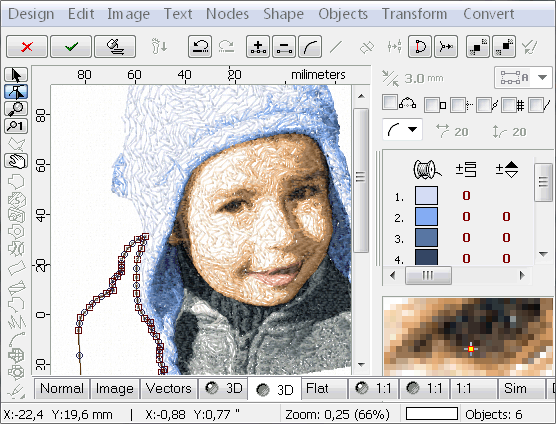
Last year I discovered that computerized embroidery machines are quite cheap and very fun to play with. I was delighted by my Brother SE400, but was also very frustrated with the software ecosystem for embroidery. In this article I’m going to attempt to help you figure out which software you need to try out.
Before we jump into that, we should clear some things up. Embroidery software is seemingly stuck in the 1990s. Everything appears to be modular, where you have to purchase different feature sets if you want to use them.
Know Your Modules
Here are the three main “modules” you need to be aware of:
Digitizing – Converts images or drawings into embroidery. Few controls for editing and adjusting. There is automatic and manual. Beginners love automatic, but you will get better results with manual. Many packages offer both to varying degrees of control.
Editing – Modifies existing embroidery files. Few controls for text.
Font/writing – Creates text. Embroidered text is a bit more complicated than simply loading a font.
Then, there’s a bunch of ancillary programs that these companies sell to do things like organize files, generate icons, etc.
For example, if you want to convert a drawing into embroidery, you need a “digitizer,” but if you want to edit that file afterwards to move some stitches around, you’ll need an “editor.” Want to plop some text in there? You’ll need to buy another module for that. Want visible icons when you’re browsing your designs? You have to buy another piece of software for that (what is this, 1996?). Even worse, each company seems to have their own definition of which features fall under what name, so just be aware that almost every company has different packages that tackle different aspects of embroidery.
I was able to get by with just a digitizer and photoshop for a long time, but ultimately purchased a font engine and editor so I could get cleaner results on text. I’ve put together a list of the common packages available with a bit of info on each. Just make sure to research whichever path you choose so you can see what needs to be purchased. Good luck.
Get Started
This article is geared toward people just getting into this field. Since this is for beginners, I have limited the cost of the software to $500 and below. You’ll find that there are many options more expensive than this. If you’re running a business, you may wish to weigh the advantages of those more costly packages.
SewArt, SewWhat, SewWrite

Offers editing, digitizing, font engine, and icon engine.
The digitizer, SewArt, is dead simple and cheap. I was able to make patches and convert designs like crazy with this. It has automatic and manual digitizing, which is nice. There aren’t a lot of options, so you may find yourself wanting better quality.
Embroideryware
This is a manual digitizer (no auto digitizing). This means that you trace over designs and set your stitch properties manually. It is also very cheap, so it may be perfect for people just getting into the hobby.
Embird, Embird Studio

Full suite of editing, digitizing, font, and icon engines. One of the modules that really caught my eye is “Sfumato stitch.” This offers a neat way to do portraits. I’d love to give this a try, but the price tag is pretty steep for someone just wanting to goof around with it (you have to buy the base program+studio+sfumato).
Embrilliance Essentials, Enthusiast, Stitch Artist
There are so many options for what modules you get and the different pricing levels, that you’ll need to do your homework just to sort out what you want to purchase. Full suite of digitizing, editing, font engines, icon engines, and more is available.
Digitize ‘N Stitch
This appears to only be a simple auto digitizer. Very few options for modifying the stitch.
Embroidermodder
Free and open source software. It is only an editor, not a digitizer. Unfortunately, this wouldn’t run on any of my four computers so I can’t recommend it.
Any Others?
Are there other options in the $500 and under price range? Please let me know, especially if you’ve tried them and can offer your thoughts and opinions. I’d love to get this list to be as helpful for beginners as possible.
ADVERTISEMENT








